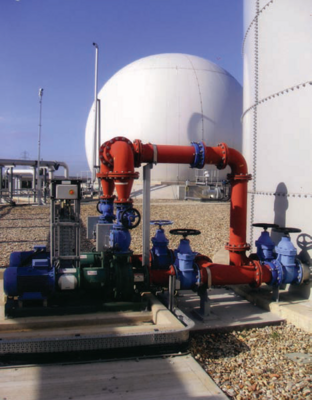The words ‘Life cycle cost’ have become familiar in the purchasing departments of the water industry, where the drive towards improved efficiency, as in many other industry sectors, is more important than ever. Viewing the trends of efficiency and cost are now more clearly documented in many engineering departments and this analysis is particularly relevant to the performance of pumps. There are examples of single pumps which cost 1000% and more of their purchase price, to run in a single year – surprising but true. In many cases these operating costs are a direct result of the presence of ‘problem’ materials such as, rag, grit, fat and hair, which account for the majority of pump failures and downtime in water and waste applications. Around seven years ago, Cambridgeshire, UK, based P&M Pumps, introduced their Rotamix and STM tank mixing systems to the UK. These systems always use a Vaughan Chopper pump to simply draw and return from the tank, vessel, lagoon etc. with the return flow being distributed through strategically placed, high velocity nozzles, creating the all important ‘Dual Zone’ mixing pattern. The chopper pump reduces any solids to ensure free flow through nozzles and thus maximum homogenous mixing. To date, over 400 Rotamix and STM systems have been installed, with tank sizes ranging from 20 cubic metres up to 6000 cubic metres. The result in all cases was better quality sludge, for example smaller solids, more consistency, ensuring better movement. This results in less pump failures in post mixing applications, less press or centrifuge maintenance, and in some cases, more than a 25% increase of sludge DS through the system. These improvements resulted in significant cost savings and as a consequence, persuaded the operators to investigate other problem areas which would benefit from potential savings. One particular pump application which emerges time and again was digester heat exchange re-circulation, especially where spiral heat exchangers are installed, as traditionally there is a tendency for them to ‘clog-up’ with rag, fat and other rogue solids. As a result of using Chopper pumps on these applications, the need to clear either the pump or the heat exchanger of regular blockages have not only been reduced, but completely eliminated. Within days of start-up, process engineers recorded a stable temperature within the digester in addition to other benefits throughout the process, following digestion. P&M Pumps realise that the efficiency of a sludge digestion treatment plant hinges upon two factors, stable temperature and homogenous sludge. Furthermore, they are confident these two factors are achieved when a Chopper pump and / or dual zone mixing system has been installed in the digester, on the heat exchangers or within any other ‘upstream’ stage of the waste water and digestion process. In most cases, retrofitting a Chopper Pump into a problematic area improves the whole process and will be self-financing, with payback periods of less than one year, thereafter minimising the effect to the budget holders.
Chopper pumps help to cut life cycle costs
The words ‘Life cycle cost’ have become familiar in the purchasing departments of the water industry
- by Vaughan Co., Inc.
- February 1, 2009
- 214 views



















